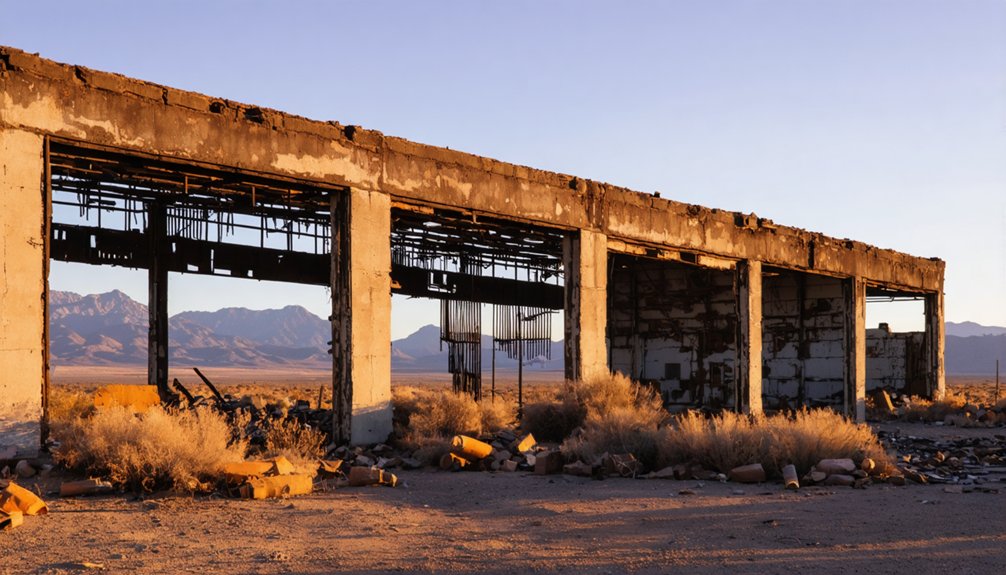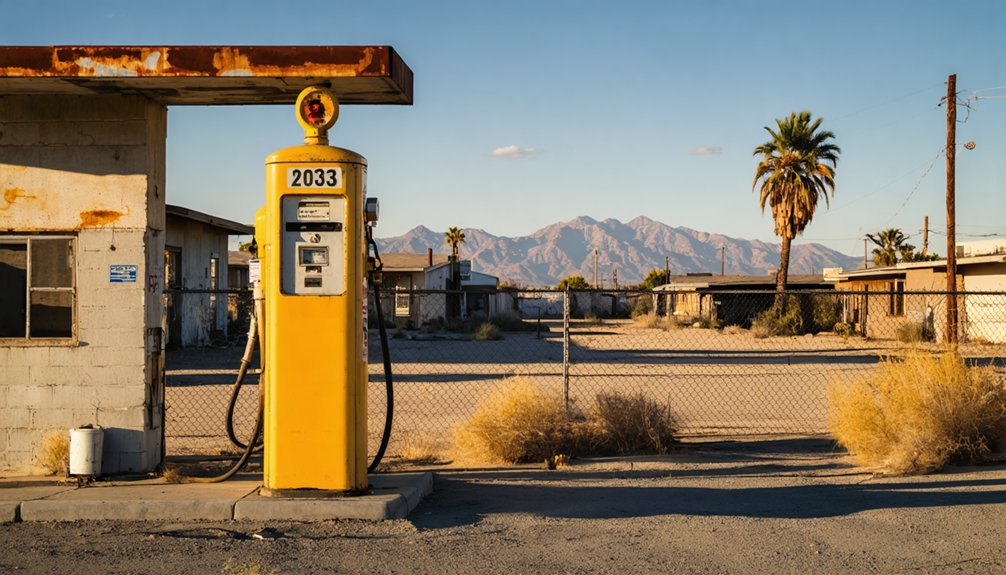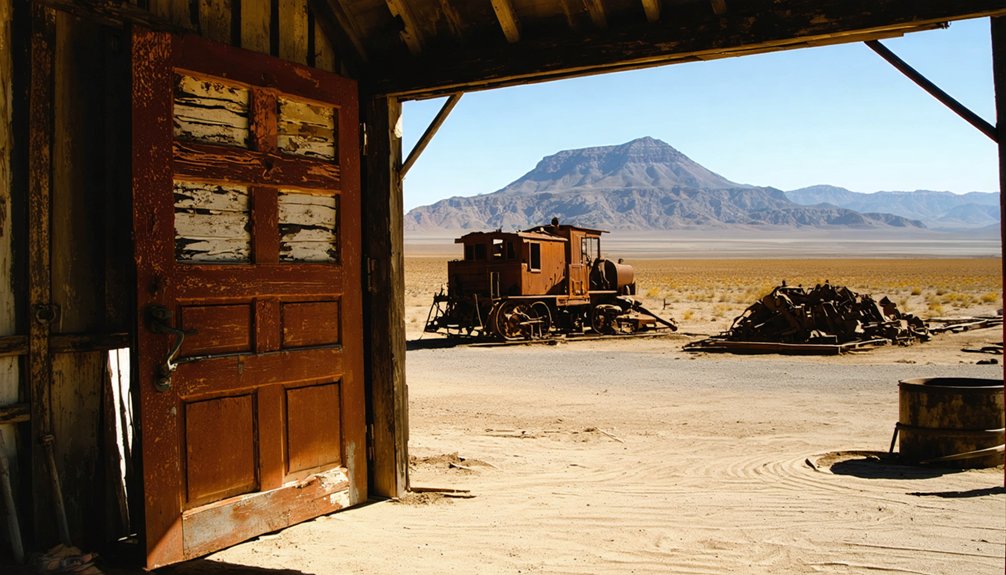Eagle Mountain was established in 1948 by industrialist Henry Kaiser as a company town supporting Southern California’s largest iron mine. You’ll find a mid-century ghost town abandoned since 1983, when its population declined from 4,000 to zero following the mine’s closure. Despite its restricted access, the site features rows of boarded homes, empty schools, and rusted machinery. Recently sold in 2023 for $22.5 million, this desert relic quietly awaits its next chapter.
Key Takeaways
- Eagle Mountain was a company town established in 1948 by Kaiser Steel to support iron mining operations in Southern California.
- The town thrived with 4,000 residents, a school, company grocery store, and recreational facilities until the mine’s closure in the early 1980s.
- After Kaiser announced the phase-out in 1981, Eagle Mountain rapidly transformed from a bustling community to a complete ghost town.
- The abandoned town now features over 400 empty homes, deserted streets, and industrial facilities with rusted machinery.
- In April 2023, the ghost town was sold for $22.5 million, with plans to convert it into a drone training facility.
Birth of a Desert Mining Town: Kaiser’s Industrial Vision
While many mining towns arose chasing gold and silver, Eagle Mountain emerged from one industrialist’s strategic vision for American steel production.
In 1945, Henry J. Kaiser acquired the Iron Chief Mine, seeing beyond the gold that fascinated earlier prospectors.
He recognized the site’s true value lay in its iron deposits—essential fuel for his Fontana steel mill.
Kaiser’s vision wasn’t merely extracting ore; he sought to build America’s first fully integrated West Coast steel operation.
Purchasing the property from Southern Pacific Railroad for $1 million, Kaiser demonstrated his commitment to expanding his industrial empire.
By 1948, Kaiser had officially founded Eagle Mountain to support his ambitious iron ore mining operations that would eventually become Southern California’s largest iron mine.
Life in the Company Town During the Mining Boom
If you’d lived in Eagle Mountain during its heyday, your daily life would have revolved around the mine’s shifts and the tight-knit community that Kaiser Steel cultivated.
You’d have sent your children to the local school, shopped at the company grocery store, and collected mail from the post office with the 92241 ZIP code.
Your weekends might’ve included community events and school activities that fostered connections among families who shared both the prosperity and isolation of their desert mining town. You could have cooled off at the community swimming pool during the scorching desert summers, one of many amenities that made Eagle Mountain feel like a modern residential town. Much like in Silverado, you would have witnessed the boom and decline of a mining town driven by economic forces beyond residents’ control.
Daily Rhythms and Routines
Eagle Mountain’s daily rhythms pulsated with the heartbeat of the mine itself, establishing a tightly synchronized community where life revolved around the 24-hour demands of iron ore extraction.
You’d find your days governed by the mine’s shift schedules, with work hours determining when you ate, slept, and socialized. The first major ore shipment from the Bald Eagle Mine occurred on October 13, 1948, marking the beginning of regular production activities that shaped town routines. As trains delivered supplies and transported ore along the 52-mile rail lifeline, community routines formed around these arrivals and departures.
Your children’s school day was deliberately aligned to complement mining operations, allowing family time despite the relentless production demands. Kaiser’s innovative health care system guaranteed you’d remain productive even as you performed physically demanding tasks, shifting from manual labor to mechanized processes over the decades. The town would experience a momentary pause every day with the scheduled daily explosions at 3:00 PM to extract ore from the mountains.
When the 1970s brought foreign competition and environmental concerns, these finely-tuned routines began to unravel.
Community and Recreation
Life in Eagle Mountain extended far beyond the mine’s demands, forging a vibrant community within the confines of Kaiser Steel’s company town model.
You’d find yourself part of a carefully designed social ecosystem where churches, a recreation hall, and the high school served as hubs for community events throughout the year.
After shifts ended, you could join neighbors at the popular bowling alley or cheer on local teams at the baseball diamond.
The café became a natural gathering spot where miners and their families shared meals and stories.
These recreational activities weren’t merely diversions—they represented Kaiser’s strategy for maintaining workforce stability and contentment.
Despite the company’s overarching control, residents created meaningful connections through these shared spaces, establishing rhythms of life that lasted until the final high school class graduated in 1983.
The town’s healthcare prepayment plan pioneered by Kaiser became a model that influenced modern health maintenance organizations across America.
The Rise and Fall of Southern California’s Iron Giant
Hidden within the rugged landscape of Southern California’s Eagle Mountains, a mining giant once stood as a symbol of America’s industrial might. Kaiser Steel’s 1945 acquisition transformed a site of modest mining activity into the Western United States’ largest iron operation, creating an industrial legacy that would last for decades. Unlike Mount Eagle in County Kerry, Ireland, this California landmark earned its reputation through industrial development rather than natural elevation.
You’ll find the mine’s history marked by impressive mining technology—massive 150-ton ore trucks, 100-car trains, and the world’s largest pelletizing plant.
From 1948 to 1982, workers extracted approximately 120 million tons of iron ore, reaching production heights of 9 million tons annually.
The thriving company town supported a community of approximately 4,000 residents during its peak years.
But foreign competition and environmental regulations tightened their grip in the 1970s. After a brief 1980 shutdown, Kaiser announced the operation’s phase-out in 1981, ending a pivotal chapter in American mining history.
Abandonment and the Eerie Transition to Ghost Town Status
Walking the deserted streets of Eagle Mountain today, you’ll encounter a community frozen at the moment of its 1982-1983 collapse, when the last residents fled following the mine’s closure.
You’re witnessing the aftermath of an economic extinction event where a once-vibrant town of 4,000 residents transformed almost overnight into rows of empty homes, abandoned storefronts, and decaying civic infrastructure. The final chapter of community life concluded when the Post Office closed in 1983, signaling the complete abandonment of the town.
The abrupt evacuation left behind an eerie time capsule of American industrial prosperity—streets still arranged in their original grid pattern while buildings slowly surrender to desert elements and occasional trespassers document the ghostly remains.
Empty Streets Await
The streets of Eagle Mountain tell a silent story of abandonment, their empty expanses bearing witness to the town’s dramatic shift from a bustling mining community to a haunting ghost town.
Where 4,000 residents once lived, you’ll now find only decaying remnants of civilization gradually reclaimed by the desert.
The haunting beauty of these abandoned structures creates a surreal landscape:
- Residential neighborhoods with homes in various states of decay, their doors ajar as if residents left in haste.
- A silent community center and empty swimming pool where children’s laughter once echoed.
- The shuttered post office and store that marked the functional end of community services in 1983.
You’re witnessing a powerful indication of industrial decline—streets named and mapped but traveled only by ghosts and curious explorers.
Life Frozen in Time
When Eagle Mountain’s iron ore mine closed in 1981, life in this once-thriving community abruptly transformed into a frozen tableau of American industrial decline.
Walking through Eagle Mountain today, you’ll find over 400 abandoned homes, empty schools, and a deserted mall—all remnants of a community that vanished almost overnight. The town’s infrastructure remains eerily intact, with streets and neighborhoods preserving the architectural footprint of 1970s America despite advancing urban decay.
Brief attempts at revival included a prison facility (1988-2003) and a contested landfill proposal, but these failed to restore liveliness.
Now, desert winds erode buildings while security guards restrict access to these crumbling time capsules. Despite minimal preservation efforts, Eagle Mountain stands as a powerful monument to resource dependency—where an entire community’s existence hinged on a single industry that disappeared.
Failed Resurrection Attempts and Post-Closure Proposals

Following the mine’s closure in 1983, Eagle Mountain faced two significant but ultimately doomed attempts at economic revival that would shape its post-mining identity.
Both failed revitalization efforts encountered substantial community resistance and logistical challenges.
First came the Eagle Mountain Community Correctional Facility in 1988, which repurposed abandoned structures until a devastating 2003 riot forced its closure.
Then Kaiser Corporation proposed transforming the mine into Los Angeles County’s landfill, sparking a 24-year battle that ended in defeat by 2013.
Three vivid remnants of these failed attempts include:
- The riot-damaged prison buildings, standing as hollow monuments to institutional failure
- Environmental impact reports gathering dust in county archives
- Faded protest signs from landfill opposition campaigns still visible on approaching roads
You’re witnessing a town twice rejected by progress.
The Mysterious 2023 Sale: New Chapter for Eagle Mountain?
Mystery shrouded Eagle Mountain once again in April 2023 when the ghost town changed hands for a staggering $22.5 million in a transaction that left locals and media outlets buzzing with speculation.
SEC filings revealed the seller as Eagle Mountain Acquisition LLC, the final Kaiser Steel subsidiary to own the property, while the mysterious buyer, Ecology Mountain Holdings LLC, remains largely unknown.
You’ll find limited information about this recently established company, registered to a Cerritos address with connections to other “Ecology” branded businesses.
The property now sits behind fences with tight security, reportedly serving as a drone training facility.
Visitors report imposing barriers and vigilant guards surrounding the former ghost town, now apparently repurposed for unmanned aerial vehicle operations.
Without official announcements about future plans, speculation continues about potential commercial or technological developments.
For now, the ghost town’s next chapter remains as enigmatic as its new owner.
Exploring Eagle Mountain’s Preserved Mid-Century Ruins Today

While most ghost towns in the American West evoke weathered wooden facades from the gold rush era, Eagle Mountain stands as a haunting monument to mid-century American industrialism.
Despite restricted access and security patrols, urban exploration enthusiasts document a time capsule of American corporate living frozen in the desert.
The town’s architectural preservation is remarkable, offering:
- Row upon row of boarded-up wooden and cinder-block homes with original paint and signage intact
- A complete community infrastructure including schools, recreation centers, and shopping areas still structurally recognizable
- Abandoned industrial facilities with rusted machinery and Kaiser Steel branding visible amid cracked pavement
Film crews regularly obtain permission to capture this postapocalyptic landscape, recognizable in movies like “Tenet” and “The Island,” while the general public glimpses it through drone footage and photography.
Frequently Asked Questions
Is It Legal to Visit Eagle Mountain Today?
No, you can’t legally visit Eagle Mountain today. It’s private property with restricted Eagle Mountain access. The ghost town tourism isn’t permitted, and security patrols actively enforce trespassing laws.
What Happened to Former Residents After the Town’s Abandonment?
Former residents faced residential relocation primarily to nearby Southern California towns. You’ll find they sought jobs in Kaiser Permanente’s healthcare network or manufacturing sectors, experiencing economic impact from their specialized mining skills becoming obsolete.
Are There Any Environmental Concerns From the Mining Operations?
You’re facing serious environmental fallout including mining pollution from contaminants in soil and water, alongside extensive habitat destruction that’s fragmented wildlife corridors for desert tortoises and bighorn sheep.
What Items and Artifacts Remain in the Abandoned Buildings?
You’ll discover abandoned relics of daily life—rusted mining equipment, decaying furniture, broken appliances, educational materials in classrooms, and prison artifacts—each preserving the historical significance of this once-thriving community.
Has Eagle Mountain Experienced Any Paranormal Activity Reports?
Shadows linger where people once lived. You’ll find reports of ghost sightings in Eagle Mountain’s abandoned structures, but they’re all anecdotal. No scientific evidence supports claims of haunted locations beyond atmospheric storytelling.
References
- https://www.photopilot.com/blog/eagle-mountain-california/
- https://secretlosangeles.com/california-largest-ghost-town-eagle-mountain/
- https://www.youtube.com/watch?v=nVaW4CNYRQY
- https://www.islands.com/1878743/one-lagest-ghost-towns-eerily-modern-abandoned-california-mining-town-eagle-mountain/
- https://www.desertusa.com/cities/ca/eagle-mountain.html
- https://www.sfgate.com/travel/article/eagle-mountain-california-ghost-town-18096768.php
- https://en.wikipedia.org/wiki/Eagle_Mountain
- https://www.youtube.com/watch?v=4abnhupnLac
- https://www.desertsun.com/story/news/2016/09/17/henry-kaiser-steel-eagle-mountain/90335270/
- https://pubs.usgs.gov/of/2001/0237/pdf/of01-237.pdf



